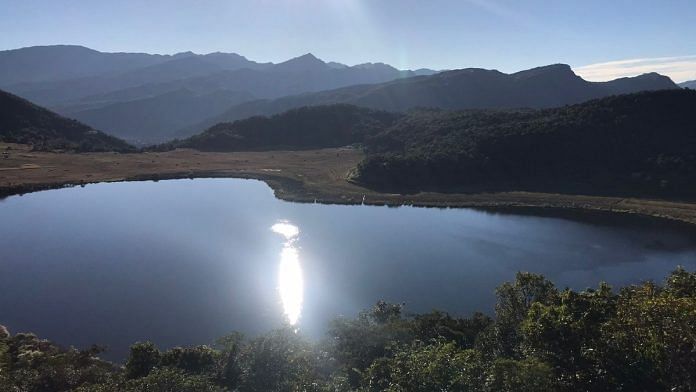Guwahati: Two teenagers from the border town of Zokhawthar in Mizoram’s Champhai district, “captured” by one of Myanmar’s ethnic armed groups in neighbouring Rihkhawdar town along the Indo-Myanmar border, were released Friday evening, security sources in Mizoram and the Chin Defense Force of Hualngoram (CDF-Hualngoram) confirmed.
The two boys, aged 15 and 16, were taken captive by CDF-Hualngoram cadres last Sunday when they along with three other Mizo boys had crossed over into Rihkhawdar town of Myanmar’s Falam district on two Kenbo motorbikes.
They were stopped by CDF-Hualngoram cadres near the Rih Dil lake and allegedly thrashed over an earlier scuffle with a member of the resistance force.
According to Indian security sources, three boys managed to escape while the other two were held hostage by CDF-Hualngoram cadres. They were kept at Rih Dil area for two days and later shifted to Zohmun Pui Camp located along the boundary of Seik village, where they were kept in a jail. The boys were tortured in captivity, sources added.
The mountainous Hualngoram region is located in the northwestern part of Myanmar, and is connected to India through the ‘Friendship Bridge’ linking the border towns of Zokhawthar in Mizoram and Rihkhawdar in Chin State.
Speaking to ThePrint, general secretary of Hualngoram People’s Organisation (HPO), Rodinga, claimed the two boys were identified for allegedly attacking a CDF-Hualngoram member, Ram Nun Sanga, on 31 August evening. Sanga was resting by the lake while on medical leave due to an injury, Rodinga added.
“After negotiating with the village council and all NGOs of Zokhawthar, the two boys who were captured for attacking our CDF member were released Friday evening,” said Rodinga.
The CDF-Hualngoram is the armed wing of the HPO that was formed in September 2021 in the wake of the military coup in Myanmar. At a time when the people of Mizoram have been showing solidarity with those displaced from Myanmar and supporting pro-democracy forces in the neighbouring country, these developments have left the host population worried, besides posing enormous challenges for security forces.
“We are almost at the edge of restraining our solidarity because of their (CDF) action here and there. They start taking our kindness for granted, their statements these days almost anger our society. If these things continue we may not be able to tolerate their status,” a villager from Champhai told ThePrint on condition of anonymity.
There are at least 18 CDFs in Myanmar’s Chin State, and some of the camps of the ethnic armed organisations, including Camp Victoria, the base of the CNA, and the Chin National Defence Force (CNDF) headquarters, are located close to Mizoram’s Champhai district.
CDF-Hualngoram operates in the three townships of Falam, Tidim and Tonzang in Chin State and together with the CNA/CNF are part of the Chinland Council.
Cautioning the host Mizo population against blindly supporting resistance groups in Myanmar, a security official in Mizoram who did not wish to be named said the situation is complicated given the “regional affiliation” of the Mizos to the resistance movement.
People living on either side of the Indo-Myanmar border largely belong to the Kuki-Chin-Zomi-Mizo tribe, bound by ethnic ties and kinship.
ThePrint earlier reported from both Indian and Myanmar border towns on how resistance groups are dependent on India for administrative needs. In December last year, ThePrint reported from Myanmar’s Rihkhawdar town on how anti-military resistance forces—the CNA, CDF-Hualngoram and others carried out joint operations near border settlements in Chin State, forcing both military and civilians to flee across the Tiau river.
Also Read: 10 chargesheeted by NIA in 2022 Mizoram arms & explosives case ‘linked to Myanmar-based insurgents’
Challenges on ground
Further, “discreet movement” of CDF cadres under the Free Movement Regime (FMR) is another challenge for the Indian security apparatus though there have been seizures of drugs and weapons from border towns. India and Myanmar share a boundary spanning 1,643 km, of which Mizoram shares a 510-km border with the neighbouring country.
The two nations share a Free Movement Regime that allows people living along the border to travel 16 kilometres into each other’s territories without a visa.
Earlier in April, External Affairs Minister S. Jaishankar, during his visit to Mizoram said that it is because of the situation in Myanmar that the Centre has taken “certain precautions”, including scrapping of the FMR between the two countries to “ensure the internal security of the country and maintain the demographic structure of India’s northeastern states”.
While acknowledging that the government is sensitive to the interests of the people, customs and traditions, and relationships across the border, Jaishankar had requested the cooperation of the people of Mizoram.
However, the state government has remained steadfast against lifting the FMR, and fencing off the Indo-Myanmar border in the state. The state has repeatedly appealed to the Centre against its decision, maintaining that the international border along Mizoram had been “arbitrarily demarcated” by the British, without considering ground realities.
Meanwhile, the HPO/CDF Hualngoram leader made mention of an “appreciation letter” from the village council and Indian NGOs in Zokhawthar for releasing the cadres, which also came with a warning from the CDF-Hualngoram for those on the Indian side of the border.
The CDF acknowledged the need to refrain from confronting armed cadres of Myanmar in their territory as the “consequences may not be favourable for both regions”.
(Edited by Amrtansh Arora)
Also Read: Facing ‘hostility’ in Myanmar, Hindu groups write to Modi, Murmu seeking change in OCI rules







The Mizos have a lot of sympathy for the Myanmarese Chin. But when it comes to Meitei Manipuris they are hostile and violent.
Mizos have always encouraged the Kuki narco-terrorists and assisted them in illegally crossing the border and settling down in the remote hill tracts of Manipur.